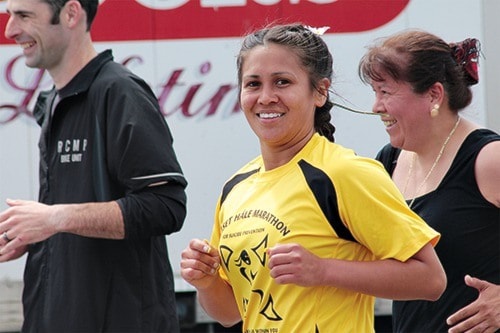An aboriginal running team is making its way down Vancouver Island to raise awareness about suicide prevention by cherishing life.
Kelly Paul is leading the Heliset Hále Marathon with teammates John Sampson and Bernice Smith. The runners and their team of supporters are of the Tsartlip First Nation, located on the Saanich Peninsula.
Their goal is to run 535 kilometres from Port Hardy to Tsartlip territory, visiting First Nation communities, high schools and middle schools along the way to share Paul’s story in hopes of inspiring other young people.
The team started its marathon May 18 and will finish in Tsartlip territory June 21 for National Aboriginal Day.
The team visited Snuneymuxw First Nation Tuesday.
“We’re running for suicide prevention,” Paul said. “About four years ago I lost a brother. He was very young at the age of 17. It was very hard and tragic for the family to go through and we’re trying to create a positive spin from something that was hard for us to something that could be a healing journey for others that could create awareness as well.”
Heliset Hále means ‘awaken life within.’ Paul’s intention is to help others value life by becoming aware of their potential, honour their gifts and to establish healthy communities by working together to gather strength.
Paul, Sampson and Smith chose a running event over cycling or another sport because they are all half-marathoners with years of running experience between them that has provided each of them physical, mental and emotional health benefits. They run 21 km per day, four days in a row, followed by a day of rest.
Paul hopes to make the run a local annual event for suicide prevention awareness within First Nations communities. She said suicide in aboriginal communities has been on the rise, but has been a taboo subject for a number of reasons, including the stigma associated with suicide and fear that talking about suicide could actually encourage others to take their own lives.
“By talking about it we create healing,” Paul said. “We need to be able to offer some kind of way to open up and talk about this, so that’s what we’re trying to do.”
Paul said suicide frequency tends to rise and fall in waves and that conditions resulting from colonization, such as residential schools, loss of language, culture and knowledge from elders, have contributed to a worsening issue.
Finding identity and a sense of purpose, Paul said, will bring healing. She also recognizes suicide is not just a First Nations problem.
Societal complications and pressures impact everyone and knowledge gained from finding ways to deal with those can be shared by all cultures.
“We are, as human people, suffering through this together,” Paul said. “We all have our own story within each of us and I think every person just needs to be heard, needs to be listened to… We are human beings, not human doings. We need to ‘be’. We need to experience life that little bit and need to be able to cheer up one another, so I believe it’s just that, going back to ‘mankind’ and listening to one another.”
